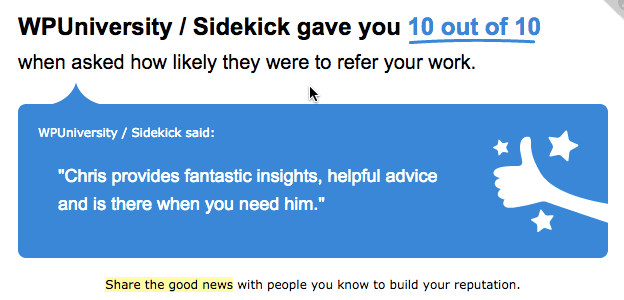
Are you collecting testimonials?
One person wrote:
“Incredibly useful, targeted advice very succinctly delivered. In this short call Chris offered smart strategies that will have a profitable impact on my bottom line. Well worth the money!”
Another wrote:
“Chris quickly honed into the heart of the issue. Offered easy to understand, actionable advice on how to gain the insight we need to move forward. Great call.”
A third wrote:
“Chris guided me into a possible business model that makes a lot of sense. He's insightful and delightful. Thanks, Chris, for your clear thinking and ability to articulate so well.”
Those were all on my clarity.fm profile where I charge people by the minute to answer their questions; questions about business models, strategy, WordPress, membership sites, and more.
I end many of my calls asking if there's anything else I can help them with, because I want to make sure the call was worth their time. They either ask a followup question or simply tell me they're happy with our call and hang up.
Either way, I end up with great quotes.
I also collect quotes on LinkedIn.
“Chris has an incredible passion and talent for what he does and it shows in the quality of his work; whether it is leading a team to develop innovative and new technical solutions, creating and delivering compelling presentations, or driving brand value through creative marketing.”
All of these help me build credibility with future customers. They're much more likely to hear and appreciate what others have to say about me than what I say about me.
Step One: Collect Testimonials
The first step, and I know this is basic, is to collect testimonials. That means using sites or services that will collect people's review of you and your work.
Even Freshbooks (online invoice software) collects reviews.

Step Two: Gather quotes & logos
On my homepage I now show some of the logos of companies in the WordPress ecosystem I've coached. I don't put quotes there.
But on some data sheets for my services I normally use the quotes, without logos.
The truth is that they're both helpful.
But if you don't have them, if you haven't pulled them together, and haven't collected logos, there's no way you can put them to work for you.
Step Three: Confirm Permission
When I was re-doing my homepage, I sent an email to each company whose logo I wanted to use – even if I hadn't coached them in 4-6 months.
I explained that I was re-doing my homepage and told them how I was using their logos.
Then I explicitly asked for permission a second time (months after collecting it) to use them.
You don't have to do this, but I think it adds that extra step that makes you look like a professional, while also saving you from PR nightmares.
You never know if there may be a good reason not to use the logo – until you ask and find out.
Lastly, put them to work for your credibility
Quotes and logos are simple and easy ways to highlight to your audience that others around you have come to appreciate you.
It's no surprise that more of Amazon's product pages are filled with product reviews than not.
They work.
So my question is, Are you letting them work for you?
- Put them on your services page.
- Put them on your homepage.
- Put them on your handouts.
- Put them in your presentations.
But whatever you do, don't put them everywhere all the time. That can get a little off-putting.
The trick is to use them strategically.
But more often than not, what I find is that most people aren't collecting them at all. And if you're not collecting positive feedback, then you'll never be able to use them effectively.
So start today.
Start asking people for reviews and testimonials.
